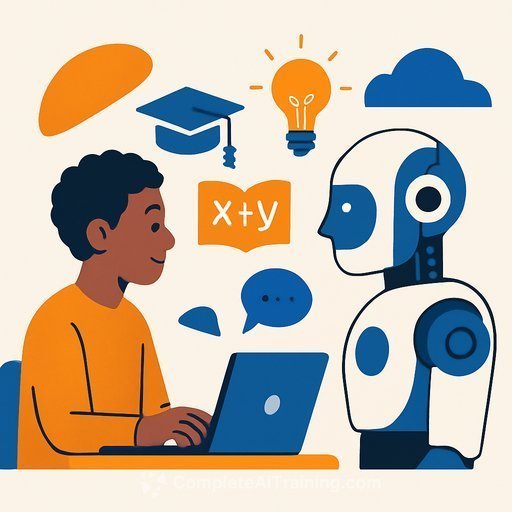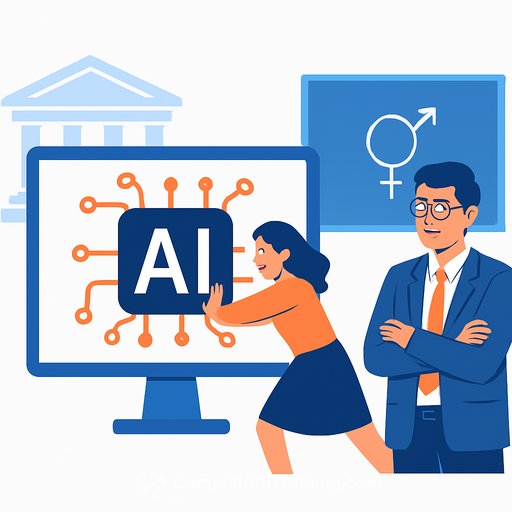How generative AI is really changing education: who produces knowledge now?
Generative AI is in the classroom. Students and staff use tools like ChatGPT, Claude, and Gemini for everything from practice questions to grading prep.
According to a report by Anthropic, 39% of student interactions with Claude are for creating or improving educational content, and 34% seek technical explanations or solutions-often producing the work itself.
Policies on plagiarism, assessment design, and job loss matter. But they miss the bigger issue: we are outsourcing the production of knowledge to a small set of tech companies. That shift affects how students think, how we define learning, and who sets the defaults for what "counts" as true.
What's actually changing
Education has long relied on human-to-human knowledge transfer. Now, AI can generate confident, polished answers on demand. The source is a black box trained on data we can't fully audit.
The line between original thought and assisted thinking blurs. Traditional skills-source evaluation, logic, weighing evidence-need new context when the "source" is a probabilistic model.
Students can deliver sophisticated outputs without the cognitive work that used to produce them. That can build momentum or short-circuit learning. The difference comes down to how we design tasks and teach process.
Co-creation or co-destruction
Students, educators, administrators, and tech providers have different goals. Students want speed. Educators want depth. Companies want engagement and adoption.
When AI helps students clarify concepts, test ideas, and revise with evidence, it creates value. When it enables shortcuts that bypass thinking, it destroys value. Treat AI as a collaborator you manage-not a ghostwriter you depend on.
The risk of outsourcing knowledge
If a few companies become the primary means of knowledge production, they set the defaults for what students see, how ideas are framed, and which sources are surfaced.
Biases in training data, optimization targets, and product incentives influence the outputs. We have seen this with social media and attention. This time, the stakes include independent thought.
Education remains essential. The task now is to define meaningful learning in an AI-saturated environment-and to keep pedagogical judgment ahead of product priorities.
What to do this semester
- Publish a clear AI-use policy for your course. Spell out permitted uses (brainstorming, outlining, code reviews), prohibited uses (full drafts, unsourced solutions), and what students must disclose.
- Require AI disclosure with evidence. Students attach prompts, key excerpts of AI output, and a short note on how they verified and revised. No detectors. Trust, verify, and grade the process.
- Redesign assessments for process + product. Collect planning notes, drafts, revision rationales, and an oral checkpoint. Reward idea quality, evidence, and improvement-not polish alone.
- Shift to authentic tasks. Use local data, fieldwork, interviews, labs, or live artifacts that generic models can't fabricate convincingly.
- Assess AI competency explicitly. Rubrics should include problem framing, prompt quality, source selection, verification steps, and limits-awareness.
- Teach AI epistemics. How models are trained, where hallucinations occur, calibration, uncertainty, and bias. Anchor with retrieval and source-tracking habits. See UNESCO's guidance on generative AI in education for policy context (UNESCO report).
- Triangulate by default. Require at least two high-quality human sources for every AI-derived claim. Make students show the evidence chain.
- Use mixed-mode verification. Short viva, whiteboard walkthrough, or studio critique to confirm authorship and depth of understanding.
- Protect time for human thinking. Run no-AI sprints, low-stakes writing, mental modeling and estimation. Build cognitive stamina.
- Do vendor due diligence. Demand clarity on data retention, training use, access controls, audit logs, content filters, and model cards. Prefer tools that support private or on-prem use for sensitive data.
Fast assessment ideas
- Compare-and-improve: Students produce an initial attempt, then use AI to critique and refine. Grade the delta and the justification.
- Evidence-first briefs: Provide the data set or source pack. Students must ground every claim in those materials, then may use AI to polish.
- Oral micro-defenses: 3-5 minute checks where students explain choices, cite sources, and respond to counterexamples.
- AI audit: Students prompt a model, identify errors and biases, and propose corrections with citations.
- Local problem studios: Projects tied to campus, community, or lab contexts, with stakeholder feedback and iteration logs.
Questions to put to any AI tool you allow
- What data of my students is stored, for how long, and where?
- Is their data used for training or product improvement? Can we disable that?
- What transparency do we get? Logs of prompts/outputs? Versioning?
- What safeguards exist against fabricated citations and unsafe content?
- Can the tool cite sources or show retrieval? How is accuracy measured?
Course policy template (copy/adapt)
- Allowed: brainstorming, outlines, code comments, translation, grammar, critique.
- Not allowed: full draft generation, unsourced solutions, citation fabrication.
- Disclosure: include prompts, key outputs, and a 150-word verification note.
- Assessment: we grade idea quality, evidence, process, and originality of thought.
- Privacy: do not upload personal or confidential data to third-party tools.
Metrics that matter
- Ratio of cited human sources to AI-derived claims.
- Number of revision cycles and quality of changes.
- Accuracy rate on fact checks of AI-assisted sections.
- Student ability to explain work without the tool.
- Observed improvement in transfer tasks (new context, same concept).
Support your staff
- Run weekly sandbox sessions for faculty to test tools against real assignments.
- Create shared prompt libraries and verification checklists.
- Collect exemplars of strong AI-assisted student work with annotations.
- Offer micro-credentials for AI in pedagogy and assessment redesign. For structured options, see a curated list of role-based programs (courses by job).
A closing thought
AI can expand access, accelerate feedback, and unlock new forms of inquiry. It can also deskill thinking if we let convenience set the terms.
Keep the locus of knowledge production in your classroom. Make process visible. Reward verification. Ask better questions than any model can answer. That's how human thought stays intact in an AI-saturated system.
Your membership also unlocks:






